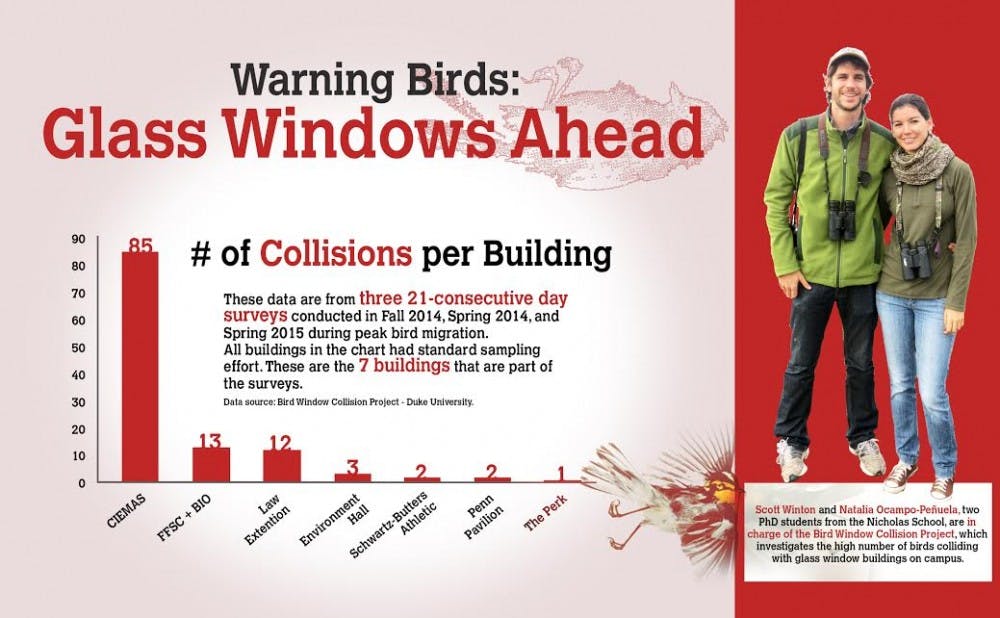New environmentally friendly buildings might be responsible for a growing number of bird deaths on Duke’s campus, research suggests.
The Bird Window Collision Project—led by Nicholas School of the Environment Ph.D. students Natalia Ocampo-Peñuela and Scott Winton and lecturer Nicolette Cagle—found that Duke’s bird safety is one of the worst in the United States and advocates for measures to remedy the problem of building collisions. The issue has been of increasing concern recently with the construction of several new buildings, including CIEMAS and Penn Pavilion, making use of large amounts of glass windows.
“Duke has a lot of buildings with a lot of glass,” Cagle said. “That glass creates a reflection, and the birds think they’re flying through forest or into a tree and instead they’re flying into a window.”
The project began in Spring 2014 because administrators were initially skeptical of their claims that bird collisions were a significant issue, Winton said. In order to convince administration to take action, the project sends volunteers around campus to record bird deaths and later compile data on the types and numbers of birds killed, as well as particularly high-risk buildings, he explained.
Since its inception, the project's surveys have uncovered more than 118 collisions around campus. Seven buildings were flagged as being particularly dangerous to birds, the worst of which was CIEMAS, which was responsible for approximately 72 percent of collisions surveyed. Penn Pavilion—which is also covered in glass—is far less risky to birds due to patterning on the glass which alerts birds to the glass' presence.
Winton added that the most high-risk buildings on Duke’s campus tend to be Leadership in Energy & Environmental Design certified, a building standard recognizing how environmentally friendly a building is. He said it is a “tragic irony” that supposedly "green" buildings are the most dangerous to wildlife.
Ocampo-Peñuela attributed the irony to problems in the certification requirements.
“To get LEED, you have to get points for many things, and you get a lot of points for natural light and beautiful views and energy efficiency, which glass windows provide,” Ocampo-Peñuela said. “Bird safety doesn’t really count towards your certification. It's really an optional thing.”
Ocampo-Peñuela noted, however, that there are strategies available, such as applying patterns or UV-reflective film to glass windows, which would make both new and old buildings safer for birds.
Cagle added that Duke’s policy toward using these resources has been inconsistent in the past, and that the buildings with patterning have suffered significantly fewer bird collisions than those that do not.
"It is not unprecedented for these modifications to be made,” she said, citing Penn Pavilion and the new Environment Hall as examples.
Winton and Ocampo-Peñuela recently helped passed a resolution in the Graduate and Professional Student Council urging the University to ensure that future construction is safer for birds on campus. Even though the University has not yet implemented a concrete bird safety policy, Ocampo-Peñuela is optimistic that it will be established soon.
“We do expect them to decide in our favor,” Ocampo-Peñuela said, noting that administration had been receptive to their request so far. “I think we’ve come a long way, and I hope I get to see a new policy before I graduate.”
Duke Facilities and Management declined to comment on any potential efforts to protect birds in time for publication.
Get The Chronicle straight to your inbox
Signup for our weekly newsletter. Cancel at any time.

